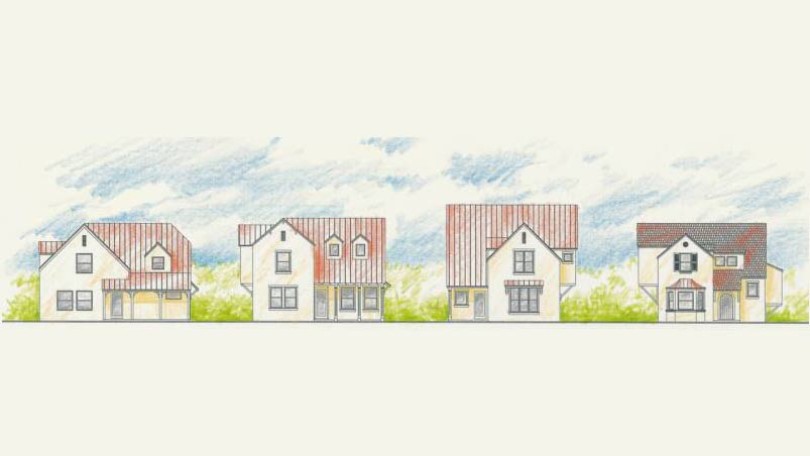Eco-Cottages in a Sustainable Setting
What is an Eco-Cottage? Well, let’s first look at the definition of cottage. After reviewing various “standard definitions” I found some reoccurring themes; small, rural, within the village context, cozy, charming, vacation, temporary, basic shelter and working class. Wikipedia adds an interesting component; “often one and a half stories with some form of dormer windows accessible from the finished attic”. My cottage forms attempt to be affordable to the average family today and use the one and a half or two story models from the twenties period group, “The Architects’ Small House Service Bureau”.
The designs you see on the Eco-Cottages page are all patterned after the Bureau’s models. I found them to be a good fit on the eco (“green”) side because; they could sit on a narrow lot (TND), have a small footprint, and have a low surface area to volume ratio.
The Narrow Lot
Directly addressing TND requirements, most of the Eco-Cottages have covered front and rear porches and allow for either detached or attached garages. Given the small footprint, more land is available for various plant forms and general open space for other activities. This format also provides for greater flexibility when the lot size increases.
A Small Footprint
If there is no dedicated insulation in a house the majority of heat-gain, here in south Florida, would be through the roof/ceiling assembly. Our designs minimize the amount of roof exposure (less roof) and thereby, after employing sprayed foam insulation, minimize possible heat-gain through the roof/ceiling assembly. Surface Area to Volume Ratio As in the geodesic dome, when lesser materials enclose a greater space an economy of materials is achieved.
Materials
From a very simple point of view, sustainable and “green” building products can be assigned some point on a linear scale. One end of the scale could be labeled extremely difficult and costly to retrofit (integral components) and the opposite end would have almost no unwarranted extra cost or difficulty to implement (surface components). Installing a greywater recycling system requires much greater effort and cost to install in an existing building than it does during new construction. Painting the exterior of an existing home requires marginally greater effort than it does for a new home. Those two examples may define opposite ends of a “green” product scale.
Another aspect in the discussion of “green” products involves cost. Here is a simple visual example. Those products we can all afford to do now are the “low hanging fruit”. Photo-Voltaics (PV) is an example of the “high fruit”. PV is costly and has a low investment to return ratio.
The Eco-Cottage should address the following six Integral Components (also see Six Key Systems);
- SIP (Structural Insulated Panels) wall/roof type of construction – minimized moisture and temperature migration, more accurate and less time to construct
- Non-vented Attic – by using either biobased water-blown healthy foam insulation spray on the underside of the roof sheathing or SIP’s at the roof a sealed, conditioned attic can be achieved. All HVAC equipment and ductwork can be installed in the attic with no degradation in performance due to excessive heat and humidity.
- Efficient, Impact Resistant Windows – several choices here, vinyl windows have many advantages
- High Efficiency HVAC System w/ Fresh Air Make-up – higher quality equipment has a lower lifecycle cost, tighter buildings require fresh air make-up input to balance interior and exterior air pressures when exhaust devices are used, avoid interior negative air pressures
- Passive Solar Water Heating – the single most powerful energy saver
- Greywater Recycling System – cleans and recycles shower, laundry and lavatory water to use for flushing toilets
The Surface Components are quite numerous and include some of the following:
- Non VOC paint
- Energy Star Appliances
- “Green” Flooring
- Lighting/Power controls
- “Green” Cabinets
- Compact Fluorescent and LED Lighting
- Metal Roofing – long life and great for catchment area of rainwater harvesting
- Photo Voltaic Panels (PV)
- Municipal Water Purification
- Tankless Gas Water Heater
- Dual Flush Toilets
Energy Production
Since PV is such a rapidly evolving technology and its cost/benefit ratio is always increasing. I will not spend much time on the subject. At this point most people in the profession advise that the intermediate urban and suburban (non-rural) user stay away from battery systems and depend on a “net metering” relationship with their local power company. In other words make as much power with PV as your pocket book will allow and sell any excess back to the power company. Buy back power as needed during times when you can’t produce it yourself. I suggest those interested in PV to do some homework on their own regarding all the evolving PV technologies via the internet. Some interesting technologies at the time of this writing are tracking CPV (concentrated photo voltaics) and PV systems with extra energy to create hydrolysis during daylight hours such that energy required for evening use is provided by the hydrogen that was stored during the day (in development at MIT).
Power from the wind? Florida, given the current cost of equipment, is not favorable for the production of wind generated power.
Certification
The certification of a home as “green” is accomplished through several different possible organizations. Two of the most recognizable in this marketplace are LEED (Leadership in Energy and Environmental Design) and FGBC (the Florida Green Building Coalition). LEED is administered under USGBC (the United States Green Building Council), a very large organization. FGBC is strictly a Florida based organization and is better equipped to deal more directly with local environmental issues. There are as many different points of view as there are people but, quite simply, I suggest LEED for commercial projects and FGBC for residential projects.
The process of certification goes something like this. A design professional (architect) can, if he/she is knowledgeable enough, design the project with all the necessary components required for “green” certification, or the design professional can engage a certified design professional that is an “expert” in “green” design, product awareness and the certification process. Once the Construction Documents (CD’s) are completed and the project is permitted the applicant retains a certifying provider which in turn provides a qualified “rating/inspecting” individual to verify the compliance of the structure, the siting of the structure and the construction process with the providers documentation. Most types of “green” certification rely on some form of point system.
Certification (and common sense) takes into account how a principal structure is placed on a site. In most residential situations there is little room for variation (as in narrow city lots or TND communities). It is reasonable to say that only the rural format (acreage) would allow for any real site planning. However, if one starts with a smaller footprint and combines it with a larger “subdivision” type of lot, possible variations could occur. One approach would be to select a model structure and then apply some basic site rules to then select the correct site for optimal orientations.
Site Considerations
From a permaculture point of view one would want a site to be as large as possible. From a TND perspective, not so much. Maybe it depends on your lifestyle… If you were to look at the SKY master Plan it would become obvious that Duany made allowances for both options and some in between.
The proper site will allow the principal structure to be situated with the majority of its roof to face south. This is done to accommodate solar water heating devices and PV panel placement on the roof. With a simple gable roof the ridge should run east-west. It is interesting to note that as the efficiency of PV increases and the cost decreases PV placement will have less and less importance since, at our latitude, the sun can be accessible, for the most part, when the panels are horizontal. If the site axis was north-south and the building ridge was east-west then the largest green portion of the lot, possibly oriented toward the kitchen, would accommodate the garden.

